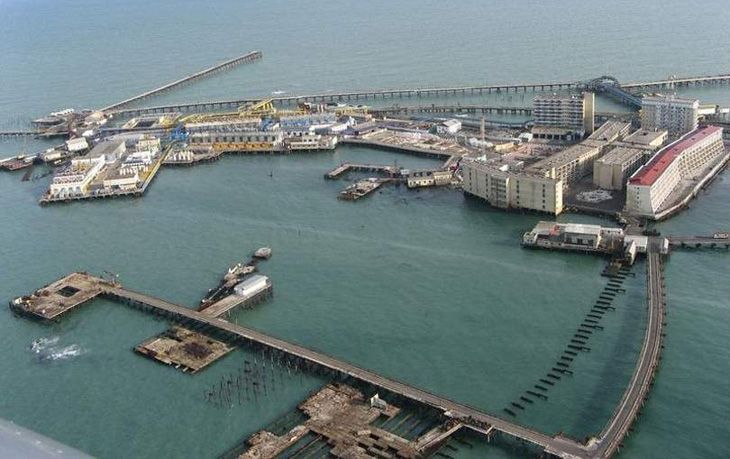Oily Rocks: World's first city on piles in open sea

The Oily Rocks is an entire city at sea, a unique technical project, located 110 kilometers off Baku, in the middle of the Caspian Sea.
Launched in 1947, the Oily Rocks platform made it into the Guinness Book of Records as the world's first offshore oil platform.
It was built in connection with the beginning of oil extraction from the seabed around the so-called Black Rocks. It is worth noting that the name of the rocks emerged from nothing. Since time immemorial, mariners noticed that both the rocks and the water around them were black from the oil seeping out of the depths.
In 1946, a large expedition was organized to the Black Rocks, which found out that there is a large oil-bearing layer under the seabed. Preparatory work was completed and on November 14, 1948, the first group of Azerbaijani oil workers arrived at the Black Rocks.
At first, everything was built on wooden piles driven into the seabed. However, this approach significantly slowed down the pace of field development, as people simply had nowhere to turn and live. As for the solution, the salvage vessel Chvanov was brought from Baku bay and sunk to keep it from sailing away. Sleeping and workplaces were arranged in the rooms of the vessel.
In the summer of 1949, the drilling of the first oil well was ready and on August 24 the crew of Mikhail Kaverochkin began its work, and by November 7, the oil well gave its first oil. The volume was astounding - 100 tons of oil were produced per day.
In honor of such an important event, the Black Rocks was renamed after the Oily Rocks.
Prior to the drilling of the second well, several more decommissioned ships were brought and turned into an artificial island, which was called the Island of Seven Ships. The vessels served as the foundation and the starting point of the embankment dam with a concrete pad, the creation of which made it possible to build multi-story houses on the Oil Rocks.
Later on, it was decided to connect the two artificial islands from the ‘dead’ ships with a trestle, towering over the sea on wooden piles. A little later, half a million meters of rocks and sand were brought onto the islands, and breakwaters and piers were built around them.
By the end of the 1950s, the Oily Rocks was already a big working settlement with two power plants, a boiler house, a bathhouse, and a medical center. Sixteen two-storied wooden barracks were built for workers.
To bring the workers to the shift, railroad tracks were laid to the Pirallahi island and a train from Baku was put in place. Later, sea communication was established directly from the Baku sea terminal.
By the 1970s, the Oily Rocks had acquired a more modern appearance. A bakery, a lemonade shop, two five-story dormitories, and one nine-story apartment building were built there. There was even a park with trees.
In 1981, a 78-kilometer pipeline to the Absheron peninsula was built for the oil to be delivered more conveniently.
Moreover, the Oily Rocks first established a full cycle of offshore operations, from exploration to transportation of raw materials by an underwater pipeline.
A total of 176 million tons of oil and more than 13 billion cubic meters of natural gas have been produced from the field at the Oily Rocks during its commissioning period.
--
Ayya Lmahamad is AzerNews’ staff journalist, follow her on Twitter: @AyyaLmahamad
Follow us on Twitter @AzerNewsAz
Here we are to serve you with news right now. It does not cost much, but worth your attention.
Choose to support open, independent, quality journalism and subscribe on a monthly basis.
By subscribing to our online newspaper, you can have full digital access to all news, analysis, and much more.
You can also follow AzerNEWS on Twitter @AzerNewsAz or Facebook @AzerNewsNewspaper
Thank you!

